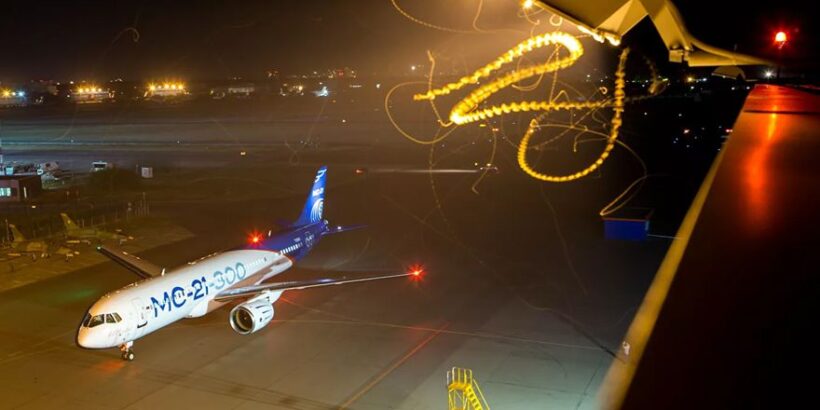The MC-21-310 aircraft, tail number 73051, is currently undergoing supplementary ground tests at the Flight Research and Development Complex (LII&DK, Lyotno-Issledovatel’skiy i Dovodochnyy Kompleks) of the Yakovlev Design Bureau in Zhukovsky, Russia. These tests aim to evaluate the aircraft’s lightning protection capabilities and represent a crucial step in the certification process for the domestically produced, import-substituted version of the MC-21. The ultimate goal is to secure design approval for the major modification involving Russian-manufactured systems. This information was disclosed by Anton Klykov, head of the Electromagnetic Compatibility and Lightning Protection Team, in the UAC (United Aircraft Corporation) MC-21 test diary.
“The lightning protection tests are conducted in collaboration with specialists from the Gromov Flight Research Institute (LII, Lyotno-Issledovatel’skiy Institut). They involve injecting a current that simulates a lightning strike through the aircraft fuselage,” Klykov stated. “The objective is to measure induced voltage levels within the aircraft’s wiring harness and to assess the lightning protection of onboard systems when lightning current flows through the airframe. This allows us to identify and mitigate potential vulnerabilities in the electrical systems, ensuring the safety and reliability of the aircraft in actual thunderstorm conditions.”
A source from Aviation of Russia within the Gromov Flight Research Institute (LII) elaborated that aircraft lightning protection tests include simulating likely lightning strike points, performing laboratory tests of equipment under high-voltage discharges and currents, and conducting full-scale tests on the aircraft itself.
“During the tests, the aircraft is subjected to current impulses of 5 kiloamperes (kA) with voltage reaching 10 kilovolts (kV). Specialized equipment records the induced electrical parameters in the cable networks. This allows us to evaluate the level of system protection against atmospheric electrical discharge during ground tests,” the source explained.
The source further noted that some international standards permit such tests to be conducted with currents up to 200 kA.
According to the scientific and technical journal “Trudy VIAM” (“Transactions of the All-Russian Institute of Aviation Materials”), in the article “Materials for Lightning Protection of Aviation Equipment,” aircraft radomes are statistically the most frequently struck by lightning. Radome materials must possess not only high mechanical strength but also low dielectric permittivity to avoid altering the characteristics of electromagnetic waves passing through them. Fiberglass, commonly used in radomes, is a dielectric material, and lightning strikes can cause it to break down, potentially disabling radio navigation systems. Carbon fiber reinforced polymers (CFRP) with conductive carbon fillers exhibit properties intermediate between metals and dielectrics, but still require additional lightning protection.
To protect structures made of polymer composite materials (PCM), special lightning protection coatings are applied, imparting electrical and thermal conductivity properties similar to metals. One effective method involves weaving metal wires, typically copper, into the carbon fiber structure. This provides reliable lightning protection without significant weight increase or loss of aerodynamic performance.
Aircraft 73051 is the first MC-21 prototype and also the first aircraft to undergo a complete wiring harness replacement, concurrently with the engine replacement with Russian-made PD-14 engines, between 2022 and 2023. By the end of 2024, the aircraft was prepared for ground lightning protection tests and is not currently performing any flights. Previously, in 2021, similar tests were conducted on this same aircraft, but at that time it was equipped with a foreign-manufactured wiring harness.
Assessing aircraft lightning protection is a comprehensive investigation aimed at enhancing the safety and reliability of airliners equipped with extensive and sophisticated electronics and systems under lightning strike conditions. These efforts are part of the import substitution program and the strengthening of technological independence of the domestic aircraft industry, Klykov concluded.


